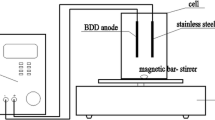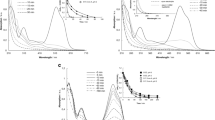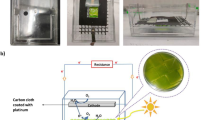Abstract
The chemical and biological mechanisms of electrochemical elimination of Microcystis aeruginosa (M. aeruginosa) using boron-doped diamond (BDD) anode were comparatively explored in three different electrolytes (chloride, sulfate, and phosphate solutions). The most efficient elimination of M. aeruginosa was observed in chloride solution, which was attributed to the greatest total long-lived oxidants from the favorable formation of active chlorine. Moreover, the high permeability of active chlorine resulted in profound intracellular damages to chlorophyll-a, microcystin-LR (MC-LR), superoxide dismutase (SOD) enzyme, and DNA in the chloride system. The change of membrane permeability and degradation of the released MC-LR induced by active chlorine were further confirmed by the increase of extracellular MC-LR in the initial 5 min and a complete decay in the subsequent 15 min, while the change in morphology of algae cells was insignificant from SEM images. In sulfate and phosphate electrolytes, membrane damages were much more pronounced based on lipid peroxidation observation, although changes in cell morphology was found more significant in phosphate system. The higher concentrations of oxidants (·OH, O3, H2O2, S2O82−) generated in sulfate than in phosphate solution explained the greater efficiency of electrochemical elimination of M. aeruginosa in the sulfate electrolyte in terms of changes of cell density, OD680, chlorophyll-a, MC-LR, lipids, SOD enzyme, and DNA.











Similar content being viewed by others
Data Availability
All data generated or analyzed during this study are included in this published article.
References
Acuna-Alonso C, Alvarez X, Lorenzo O, Cancela A, Valero E, Sanchez A (2021): Water toxicity in reservoirs after freshwater algae harvest J Clean Prod 283 124560
Ahmed MM, Muller W, Ismail AMA (1995) The influence of electrochemical treatment of water on Chlorella-vulgaris with reference to the use of copper and zinc electrodes. Zentralbl Hyg Umweltmed 197:534–542
Antoniou MG, de la Cruz AA, Dionysiou DD (2005): Cyanotoxins: new generation of water contaminants. J. Environ. Eng.-ASCE 131, 1239–1243
Antoniou MG, de la Cruz AA, Dionysiou DD (2010) Intermediates and reaction pathways from the degradation of Microcystin-LR with sulfate radicals. Environ Sci Technol 44:7238–7244
Antonopoulou M, Evgenidou E, Lambropoulou D, Konstantinou I (2014) A review on advanced oxidation processes for the removal of taste and odor compounds from aqueous media. Water Res 53:215–234
APHA (2005) Standard methods for the examination of water and wastewater, 21st edn. American Public Health Association, Washington, DC
Bader H, Hoigne J (1981) Determination of ozone in water by the indigo method. Water Res 15:449–456
Bakheet B, Islam MA, Beardall J, Zhang XW, McCarthy D (2018) Electrochemical inactivation of Cylindrospermopsis raciborskii and removal of the cyanotoxin cylindrospermopsin. J Hazard Mater 344:241–248
Barrington DJ, Ghadouani A (2008) Application of hydrogen peroxide for the removal of toxic cyanobacteria and other phytoplankton from wastewater. Environ Sci Technol 42:8916–8921
Ben Ghorbal SK, Maalej L, Chourabi K, Khefacha S, Ouzari HI, Chatti A (2016) Antioxidant defense mechanisms in Pseudomonas aeruginosa: role of iron-cofactored superoxide dismutase in response to UV-C radiations. Curr Microbiol 73:159–164
Benoufella F, Laplanche A, Boisdon V, Bourbigot MM (1994) Elimination of microcystis cyanobacteria (blue-green-algae) by an ozoflotation process — a pilot-plant study. Water Sci Technol 30:245–257
Chaplin BP (2019) The prospect of electrochemical technologies advancing worldwide water treatment. Acc Chem Res 52:596–604
Chen JJ, Yeh HH (2005) The mechanisms of potassium permanganate on algae removal. Water Res 39:4420–4428
Chen YM, Liu JC, Ju YH (1998) Flotation removal of algae from water. Colloid Surf B Biointerfaces 12:49–55
Cho M, Kim J, Kim JY, Yoon J, Kim J-H (2010) Mechanisms of Escherichia coli inactivation by several disinfectants. Water Res 44:3410–3418
Chow CWK, Panglisch S, House J, Drikas M, Burch MD, Gimbel R (1997): A study of membrane filtration for the removal of cyanobacterial cells. J Water Serv Res Technol Aqua 46 324 334
Chow CWK, House J, Velzeboer RMA, Drikas M, Burch MD, Steffensen DA (1998) The effect of ferric chloride flocculation on cyanobacterial cells. Water Res 32:808–814
Chow CWK, Drikas M, House J, Burch MD, Velzeboer RMA (1999) The impact of conventional water treatment processes on cells of the cyanobacterium Microcystis aeruginosa. Water Res 33:3253–3262
Fan J, Ho L, Hobson P, Brookes J (2013) Evaluating the effectiveness of copper sulphate, chlorine, potassium permanganate, hydrogen peroxide and ozone on cyanobacterial cell integrity. Water Res 47:5153–5164
Farhat A, Keller J, Tait S, Radjenovic J (2015) Removal of persistent organic contaminants by electrochemically activated sulfate. Environ Sci Technol 49:14326–14333
Ghernaout B, Ghernaout D, Saiba A (2010) Algae and cyanotoxins removal by coagulation/flocculation: a review. Desalin Water Treat 20:133–143
Haughey MA, Anderson MA, Whitney RD, Taylor WD, Losee RF (2000) Forms and fate of Cu in a source drinking water reservoir following CuSO4 treatment. Water Res 34:3440–3452
Huang KC, Couttenye RA, Hoag GE (2002) Kinetics of heat-assisted persulfate oxidation of methyl tert-butyl ether (MTBE). Chemosphere 49:413–420
Jeong J, Kim JY, Yoon J (2006) The role of reactive oxygen species in the electrochemical inactivation of microorganisms. Environ Sci Technol 40:6117–6122
Jeong J, Kim C, Yoon J (2009) The effect of electrode material on the generation of oxidants and microbial inactivation in the electrochemical disinfection processes. Water Res 43:895–901
Jiang W, Chen L, Batchu SR, Gardinali PR, Jasa L, Marsalek B, Zboril R, Dionysiou DD, O’Shea KE, Sharma VK (2014) Oxidation of microcystin-LR by ferrate(VI): kinetics, degradation pathways, and toxicity assessments. Environ Sci Technol 48:12164–12172
Leung TY, Chan CY, Hu C, Yu JC, Wong PK (2008) Photocatalytic disinfection of marine bacteria using fluorescent light. Water Res 42:4827–4837
Li HN, Zhu XP, Jiang Y, Ni JR (2010a) Comparative electrochemical degradation of phthalic acid esters using boron-doped diamond and Pt anodes. Chemosphere 80:845–851
Li HN, Zhu XP, Ni JR (2010b) Inactivation of Escherichia coli in Na2SO4 electrolyte using boron-doped diamond anode. Electrochim Acta 56:448–453
Liang WY, Qu JH, Chen LB, Liu HJ, Lei PJ (2005) Inactivation of Microcystis aeruginosa by continuous electrochemical cycling process in tube using Ti/RuO2 electrodes. Environ Sci Technol 39:4633–4639
Lin L, Meng XY, Li QY, Huang Z, Wang LL, Lin K, Chen J, Crittenden J (2018) Electrochemical oxidation of Microcystis aeruginosa using a Ti/RuO2 anode: contributions of electrochemically generated chlorines and hydrogen peroxide. Environ Sci Pollut Res 25:27924–27934
Long YJ, Ni JR, Wang ZH (2015) Subcellular mechanism of Escherichia coli inactivation during electrochemical disinfection with boron-doped diamond anode: a comparative study of three electrolytes. Water Res 84:198–206
Ma M, Liu RP, Liu HJ, Qu JH (2012) Chlorination of Microcystis aeruginosa suspension: cell lysis, toxin release and degradation. J Hazard Mater 217:279–285
Mascia M, Monasterio S, Vacca A, Palmas S (2016) Electrochemical treatment of water containing Microcystis aeruginosa in a fixed bed reactor with three-dimensional conductive diamond anodes. J Hazard Mater 319:111–120
Pigeot-Remy S, Simonet F, Atlan D, Lazzaroni JC, Guillard C (2012) Bactericidal efficiency and mode of action: a comparative study of photochemistry and photocatalysis. Water Res 46:3208–3218
Pinto BR, Linares JJ, Lanza MRD, Souza FD (2021) UV-irradiation and BDD-based photoelectrolysis for the treatment of halosulfuron-methyl herbicide. Environ Sci Pollut Res 28:26762–26771
Qu FS, Liang H, Tian JY, Yu HR, Chen ZL, Li GB (2012) Ultrafiltration (UF) membrane fouling caused by cyanobateria: fouling effects of cells and extracellular organics matter (EOM). Desalination 293:30–37
Radjenovic J, Sedlak DL (2015) Challenges and opportunities for electrochemical processes as next-generation technologies for the treatment of contaminated water. Environ Sci Technol 49:11292–11302
Schmalz V, Dittmar T, Haaken D, Worch E (2009) Electrochemical disinfection of biologically treated wastewater from small treatment systems by using boron-doped diamond (BDD) electrodes — contribution for direct reuse of domestic wastewater. Water Res 43:5260–5266
Sehnal L, Prochazkova T, Smutna M, Kohoutek J, Lepsova-Skacelova O, Hilscherova K (2019) Widespread occurrence of retinoids in water bodies associated with cyanobacterial blooms dominated by diverse species. Water Res 156:136–147
Tai C, Peng JF, Liu JF, Jiang GB, Zou H (2004) Determination of hydroxyl radicals in advanced oxidation processes with dimethyl sulfoxide trapping and liquid chromatography. Anal Chim Acta 527:73–80
Tripathi BN, Mehta SK, Amar A, Gaur JP (2006) Oxidative stress in Scenedesmus sp during short- and long-term exposure to Cu2+ and Zn2+. Chemosphere 62:538–544
Westrick JA, Szlag DC, Southwell BJ, Sinclair J (2010) A review of cyanobacteria and cyanotoxins removal/inactivation in drinking water treatment. Anal Bioanal Chem 397:1705–1714
WHO (1997) Guideline from Drinking Water Quality, 2nd edn. World Health Organization, Geneva, Switzerland
Yao YY, Kubota Y, Murakami T, Ochiai T, Ishiguro H, Nakata K, Fujishima A (2011) Electrochemical inactivation kinetics of boron-doped diamond electrode on waterborne pathogens. J Water Health 9:534–543
Yu FK, Zhou MH, Yu XM (2015) Cost-effective electro-Fenton using modified graphite felt that dramatically enhanced on H2O2 electro-generation without external aeration. Electrochim Acta 163:182–189
Zhang YR, Zhang Y, Yang N, Liao WJ, Yoshihara S (2013) Electrochemical degradation and mechanistic analysis of microcystin-LR. J Chem Technol Biotechnol 88:1529–1537
Zhou SQ, Bu LJ, Shi Z, Deng L, Zhu SM, Gao NY (2018) Electrochemical inactivation of Microcystis aeruginosa using BDD electrodes: kinetic modeling of microcystins release and degradation. J Hazard Mater 346:73–81
Zhu XP, Tong MP, Shi SY, Zhao HZ, Ni JR (2008) Essential explanation of the strong mineralization performance of boron-doped diamond electrodes. Environ Sci Technol 42:4914–4920
Zou XT, Xu KW, Xue YT, Qu YH, Li YP (2020) Removal of harmful algal blooms in freshwater by buoyant-bead flotation using chitosan-coated fly ash cenospheres. Environ Sci Pollut Res 27:29239–29247
Funding
This work was supported by the National Natural Science Foundation of China (No. 51721006) and Jiangsu Agriculture Science and Technology Innovation Fund (JASTIF No. CX(20)1011).
Author information
Authors and Affiliations
Contributions
Yujiao Long: Methodology, Validation, Formal analysis, Investigation, Data Curation, Writing—Original Draft, Visualization. Hongna Li: Writing—Review & Editing. Hongmei Jin: Writing—Review & Editing, Funding acquisition. Jinren Ni: Conceptualization, Writing—Review & Editing, Supervision, Project administration, Funding acquisition.
Corresponding author
Ethics declarations
Ethics approval and consent to participate
Not applicable.
Consent for publication
Not applicable.
Competing interests
The authors declare no competing interests.
Additional information
Responsible Editor: Vitor Vasconcelos
Publisher's Note
Springer Nature remains neutral with regard to jurisdictional claims in published maps and institutional affiliations.
Rights and permissions
About this article
Cite this article
Long, Y., Li, H., Jin, H. et al. Electrochemical elimination of Microcystis aeruginosa with boron-doped diamond anode in different electrolyte systems: chemical and biological mechanisms. Environ Sci Pollut Res 29, 27677–27687 (2022). https://doi.org/10.1007/s11356-021-18254-z
Received:
Accepted:
Published:
Issue Date:
DOI: https://doi.org/10.1007/s11356-021-18254-z




